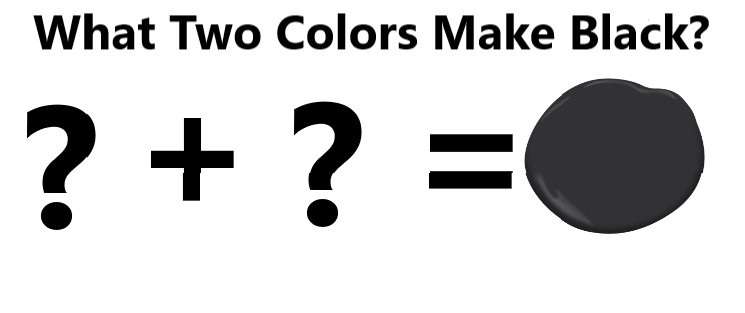What Two Colors Make Black Paint

We've all been there: staring at a shelf full of paint, realizing you need black, but only have a rainbow of other colors. Or maybe you're a custom car builder striving for that *perfect* shade of midnight. Understanding color mixing to achieve black might seem basic, but the nuances are crucial for consistent, high-quality results, especially in automotive applications. This article breaks down the seemingly simple question, "What two colors make black paint?" and delves into the technical aspects relevant to auto enthusiasts like you. We'll explore the theory, practical considerations, and potential pitfalls, giving you the knowledge to confidently mix your own black paint for touch-ups, custom jobs, or even just understanding how paint works.
The Quest for True Black: It's Complicated
While the straightforward answer might seem to be any two complementary colors, achieving a truly neutral, deep black is rarely that simple. The issue is that most readily available pigments are not pure. They tend to lean towards certain color biases. Mixing two biased colors will likely result in a muddy brown or a black with an undesirable undertone (greenish, reddish, or bluish). Therefore, we have to use multiple colors to create a true black.
Color Theory Basics: Subtractive Mixing
Before diving into specific color combinations, let's quickly review the basics of subtractive color mixing, which is how paint works. Unlike additive mixing (light), where adding colors together produces lighter colors (eventually white), subtractive mixing involves pigments that absorb certain wavelengths of light and reflect others. The colors we see are the wavelengths that are reflected. When you mix paints, you're essentially combining pigments that absorb different wavelengths, resulting in a color that reflects even fewer wavelengths. The more colors you mix, the more wavelengths are absorbed, leading towards black.
Think of it like this: a red pigment absorbs most wavelengths *except* red, which it reflects back to our eyes. A blue pigment absorbs most wavelengths *except* blue. When you mix them, the resulting mixture absorbs most wavelengths *except* maybe a little bit of purple, so you see purple. This process is crucial to understand why achieving a true black with just two colors is difficult in practice.
Key Pigments for Achieving Black
While two colors are not sufficient for an ideal black, the following pigments are essential components in creating black paint.
- Lamp Black: This is a common black pigment made from soot. It's generally a very deep, neutral black, but can sometimes have a slightly bluish undertone.
- Ivory Black (Bone Black): Made from charred animal bones, this pigment tends to have a warmer, slightly brownish undertone.
- Mars Black: A synthetic iron oxide pigment, Mars Black is very opaque and durable. It also usually has a slight brown/reddish undertone.
- Phthalo Blue (Green Shade): This intense, vibrant blue can be used in small quantities to adjust the undertone of a black mix, pushing it towards a cooler, more neutral shade if it's too warm.
- Quinacridone Violet: Similar to Phthalo Blue, a tiny amount of this can help adjust the undertone, particularly if the black is leaning greenish.
A More Realistic Approach: Three-Color Combinations
Because most paints have a tint and we need to achieve a neutral tone, it’s more practical to use three colors.
- A Balanced Approach: Start with a base of a dark, neutral grey created by mixing white with a small amount of black. This helps to eliminate bias in your black and makes it easier to adjust. Then add Burnt Umber (for warmth) and Phthalo Blue (for coolness) in small increments until you achieve the desired depth and neutrality.
Understanding the Recipe: Color Formulas & Measurement
When following a color formula, or recipe, use a scale to measure the paint accurately. A slight change in weight can change the color tint of the resultant mixture.
Real-World Use: Basic Troubleshooting Tips
Problem: Black paint is too brown.
Solution: Add a tiny amount of Phthalo Blue or a Quinacridone Violet to cool down the mix. Be extremely cautious with the amount – a little goes a long way!
Problem: Black paint is too blue.
Solution: Add a touch of Burnt Umber or a small amount of yellow ochre to introduce some warmth and counteract the blue.
Problem: Black paint is too grey, not deep enough.
Solution: Add more black pigment! You may also need to re-evaluate the proportions of your initial mix to ensure a sufficient concentration of dark pigments.
Problem: The mixed color is muddy.
Solution: You've likely mixed too many colors, or the colors you've used contain a lot of filler pigments that mute the result. Consider starting over with fewer, higher-quality pigments.
Safety Considerations
Always wear appropriate personal protective equipment (PPE) when working with paints, including:
- Respirator: Protects against harmful fumes, especially when spraying automotive paints containing solvents.
- Gloves: Prevents skin contact with pigments and solvents, which can cause irritation or allergic reactions. Nitrile gloves are ideal.
- Eye Protection: Safety glasses or a face shield protect your eyes from splashes and fumes.
- Ventilation: Work in a well-ventilated area to minimize exposure to harmful vapors. Use a spray booth with proper exhaust if possible.
Important Note: Some pigments, like those containing lead or cadmium (though less common now), are toxic. Always read the product safety data sheet (SDS) for any paint you use and follow the manufacturer's safety recommendations. Dispose of paint waste properly according to local regulations.
Achieving a perfect black paint mix takes practice and attention to detail. By understanding the principles of subtractive color mixing, the characteristics of different pigments, and the importance of careful measurement, you can confidently create custom black paint for your automotive projects. Experiment, take notes, and don't be afraid to adjust your formulas based on your specific needs and the characteristics of the paints you are using.
